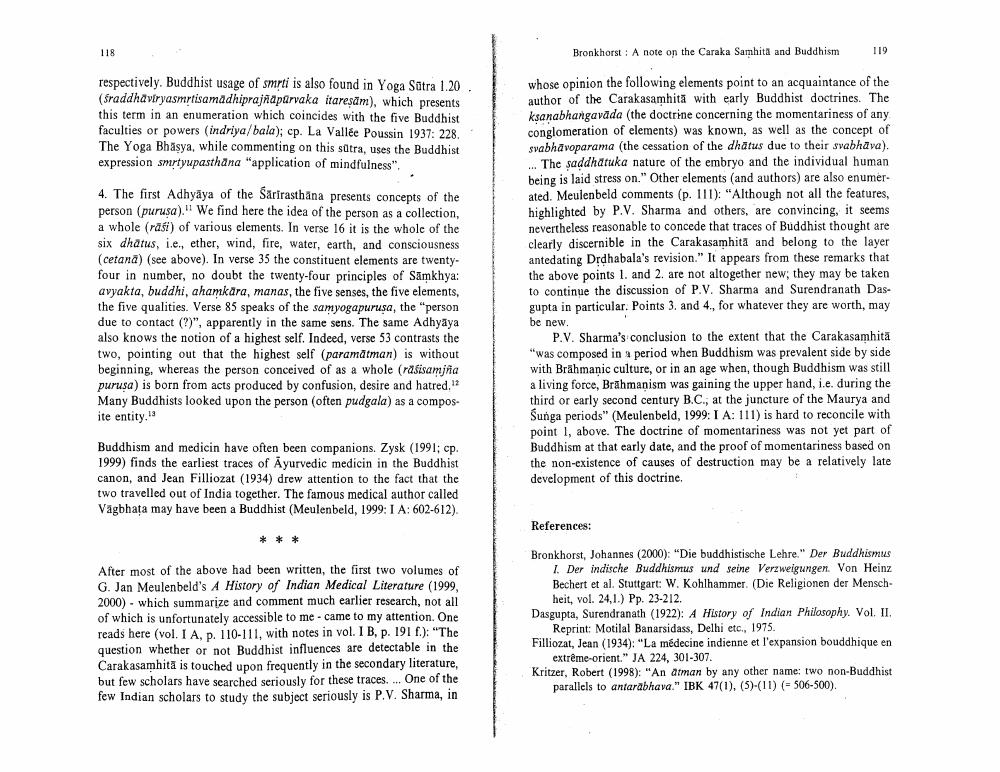Book Title: Note On Caraka Samhita And Buddhism Author(s): Johannes Bronkhorst Publisher: Johannes Bronkhorst View full book textPage 3
________________ 118 Bronkhorst: A note on the Caraka Samhita and Buddhism 119 respectively. Buddhist usage of smrti is also found in Yoga Sätra 1.20 (Sraddha viryasmrtisamadhiprajnaparvaka itaresām), which presents this term in an enumeration which coincides with the five Buddhist faculties or powers (indriya/ bala); cp. La Vallée Poussin 1937: 228. The Yoga Bhasya, while commenting on this sutra, uses the Buddhist expression smrtyupasthāna "application of mindfulness" 4. The first Adhyāya of the Särirasthana presents concepts of the person (purusa)." We find here the idea of the person as a collection, a whole (rasi) of various elements. In verse 16 it is the whole of the six dhatus, i.e., ether, wind, fire, water, earth, and consciousness (cetana) (see above). In verse 35 the constituent elements are twentyfour in number, no doubt the twenty-four principles of Samkhya: avyakta, buddhi, ahamkara, manas, the five senses, the five elements, the five qualities. Verse 85 speaks of the samyogapurusa, the person due to contact (?)", apparently in the same sens. The same Adhyāya also knows the notion of a highest self. Indeed, verse 53 contrasts the two, pointing out that the highest self (paramātman) is without beginning, whereas the person conceived of as a whole (rasisamjila purusa) is born from acts produced by confusion, desire and hatred," Many Buddhists looked upon the person (often pudgala) as a composite entity." whose opinion the following elements point to an acquaintance of the author of the Carakasamhita with early Buddhist doctrines. The ksanabhangavada (the doctrine concerning the momentariness of any conglomeration of elements) was known, as well as the concept of svabha voparama (the cessation of the dhatus due to their swabhava). ... The saddhatuka nature of the embryo and the individual human being is laid stress on." Other elements (and authors) are also enumerated. Meulenbeld comments (p. 111): "Although not all the features, highlighted by P.V. Sharma and others, are convincing, it seems nevertheless reasonable to concede that traces of Buddhist thought are clearly discernible in the Carakasamhita and belong to the layer antedating Drdhabala's revision." It appears from these remarks that the above points 1 and 2. are not altogether new, they may be taken to continue the discussion of P.V. Sharma and Surendranath Dasgupta in particular. Points 3. and 4, for whatever they are worth, may be new. P.V. Sharma's conclusion to the extent that the Carakasamhita "was composed in a period when Buddhism was prevalent side by side with Brahmanic culture, or in an age when, though Buddhism was still a living force, Brahmanism was gaining the upper hand, i.e. during the third or early second century B.C., at the juncture of the Maurya and Sunga periods" (Meulenbeld, 1999: I A: 111) is hard to reconcile with point I, above. The doctrine of momentariness was not yet part of Buddhism at that early date, and the proof of momentariness based on the non-existence of causes of destruction may be a relatively late development of this doctrine. Buddhism and medicin have often been companions. Zysk (1991; cp. 1999) finds the earliest traces of Ayurvedic medicin in the Buddhist canon, and Jean Filliozat (1934) drew attention to the fact that the two travelled out of India together. The famous medical author called Vägbhata may have been a Buddhist (Meulenbeld, 1999: I A: 602-612). References: After most of the above had been written, the first two volumes of G. Jan Meulenbeld's A History of Indian Medical Literature (1999, 2000) - which summarize and comment much earlier research, not all of which is unfortunately accessible to me - came to my attention. One reads here (vol. I A, p. 110-111, with notes in vol. I B, p. 191 f.): "The question whether or not Buddhist influences are detectable in the Carakasamhita is touched upon frequently in the secondary literature, but few scholars have searched seriously for these traces. ... One of the few Indian scholars to study the subject seriously is P.V. Sharma, in Bronkhorst, Johannes (2000): "Die buddhistische Lehre." Der Buddhismus I Der indische Buddhismus und seine Verzweigungen. Von Heinz Bechert et al. Stuttgart: W. Kohlhammer. (Die Religionen der Mensch heit, vol. 24,1.) Pp. 23-212. Dasgupta, Surendranath (1922): A History of Indian Philosophy. Vol. II, Reprint: Motilal Banarsidass, Delhi etc., 1975. Filliozat, Jean (1934): "La médecine indienne et l'expansion bouddhique en extrême-Orient." JA 224, 301-307. Kritzer, Robert (1998): "An atman by any other name: two non-Buddhist parallels to antarabhava." IBK 47(1), (5)-(11) = 506-500).Page Navigation
1 2 3 4
